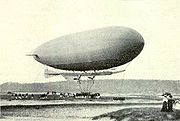
Hans Georg Friedrich Groß
Encyclopedia
Hans Georg Friedrich Groß, (4 May 1860 - 27 February 1924), was a German
balloonist and airship
constructor.
. Hans Groß was Premiereleutnant of the Berliner Luftschifferabteilung (Berlin airship department), and as balloon pilot took part in 28 of these studies.
Hydrogen balloon plans by Groß led to the construction of the Humboldt. This performed six ascents, two ending in non-fatal crashes; during deflation after its final landing in 26 April 1893 it exploded due to electrostatic charging and burnt. For his next balloon, the Phönix, Groß developed a variant of the Reißbahn invented by John Wise
in 1844. This allowed the pilot to rapidly deflate a gas balloon upon landing. The Phönix performed 23 manned ascents from 1893 to 1896, a total 180 hours in the air and reached a maximum altitude of 9155 metres on 1894-12-04 with Arthur Berson
.
 In 1895 and 1896 Groß supported David Schwarz
In 1895 and 1896 Groß supported David Schwarz
in the development of his metal-clad airship
.
In 1906 Groß rose in rank to Major and became commander of the Royal Prussian Airship Battalion Number 2. With Nikolaus Basenach in 1906 he started construction of the first German military airship, an experimental keeled semi-rigid airship
. This became designated the Groß-Basenach
-type and resulted in a Versuchsluftschiff (first flight 5 July 1907) followed by the airships M I (first flight 1908-06-30) to M IV. M I achieved a distance record of 300 kilometres over thirteen hours in 11 and 12 September 1908.
In 1910 he was honoured by having the street Großstraße in Berlin-Köpenick
named after him. Groß retired from active service in 1918 with the rank of Major General
.
Germany
Germany , officially the Federal Republic of Germany , is a federal parliamentary republic in Europe. The country consists of 16 states while the capital and largest city is Berlin. Germany covers an area of 357,021 km2 and has a largely temperate seasonal climate...
balloonist and airship
Airship
An airship or dirigible is a type of aerostat or "lighter-than-air aircraft" that can be steered and propelled through the air using rudders and propellers or other thrust mechanisms...
constructor.
Balloons
In the 1890s the Verein zur Förderung der Luftschifffahrt (an association promoting airflight founded in 1881) conducted scientific balloon ascents to study the upper atmosphere on the initiative of Richard AssmannRichard Assmann
Richard Assmann ; was a German meteorologist and physician who was a native of Magdeburg....
. Hans Groß was Premiereleutnant of the Berliner Luftschifferabteilung (Berlin airship department), and as balloon pilot took part in 28 of these studies.
Hydrogen balloon plans by Groß led to the construction of the Humboldt. This performed six ascents, two ending in non-fatal crashes; during deflation after its final landing in 26 April 1893 it exploded due to electrostatic charging and burnt. For his next balloon, the Phönix, Groß developed a variant of the Reißbahn invented by John Wise
John Wise (balloonist)
John Wise was a pioneer in the field of ballooning. He made over 400 flights during his lifetime and was responsible for several innovations in balloon design...
in 1844. This allowed the pilot to rapidly deflate a gas balloon upon landing. The Phönix performed 23 manned ascents from 1893 to 1896, a total 180 hours in the air and reached a maximum altitude of 9155 metres on 1894-12-04 with Arthur Berson
Arthur Berson
Arthur Josef Stanislaus Berson was a Polish meteorologist and pioneer of aerology who was a native of Neu Sandez, Galicia ....
.
Airships

David Schwarz (aviation inventor)
David Schwarz was a Hungarian aviation pioneer of Jewish descent.Schwarz created the first flyable rigid airship. It was also the first airship with an external hull made entirely of metal. He died before he could see it finally fly...
in the development of his metal-clad airship
Metal-clad airship
Metal-clad airships are airships which utilize a very thin, airtight metal envelope, rather than the usual rubber-coated fabric envelope. The shell may be either internally braced as with the designs of David Schwarz, or monocoque as in the ZMC-2...
.
In 1906 Groß rose in rank to Major and became commander of the Royal Prussian Airship Battalion Number 2. With Nikolaus Basenach in 1906 he started construction of the first German military airship, an experimental keeled semi-rigid airship
Semi-rigid airship
Semi-rigid airships are airships with a partial framework. These often consist of a rigid, or occasionally, flexible, keel frame along the long axis under the aerodynamic hull envelope. The partial framework can also be located inside the hull...
. This became designated the Groß-Basenach
Groß-Basenach
Gross-Basenach or Groß-Basenach is the designation for a series of five so-called M-class German military semi-rigid airships constructed by the well-known balloonist Nikolaus Basenach and Major Hans Georg Friedrich Groß of the Royal Prussian Airship Battalion Nr 2 between 1907 and 1914.They...
-type and resulted in a Versuchsluftschiff (first flight 5 July 1907) followed by the airships M I (first flight 1908-06-30) to M IV. M I achieved a distance record of 300 kilometres over thirteen hours in 11 and 12 September 1908.
In 1910 he was honoured by having the street Großstraße in Berlin-Köpenick
Köpenick
Köpenick is a historic town and locality that is situated at the confluence of the rivers Dahme and Spree in the south-east of the German capital city of Berlin. It was formerly known as Copanic and then Cöpenick, only officially adopting the current spelling in 1931...
named after him. Groß retired from active service in 1918 with the rank of Major General
Major General
Major general or major-general is a military rank used in many countries. It is derived from the older rank of sergeant major general. A major general is a high-ranking officer, normally subordinate to the rank of lieutenant general and senior to the ranks of brigadier and brigadier general...
.

